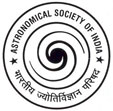May 2018:
The AstroSat Picture of the Month for May 2018 is the X-ray data from the Crab Nebula, using the ASTROSAT. The left panel shows the new result. One rotation period of the Crab Pulsar, of 33 milliseconds, is represented as the phase going from 0.0 to 1.0 and is repeated once more, from 1.0 to 2.0, for clarity. The grey line is the X-ray brightness of the Crab lighthouse, observed by CZTI. The data in colour, obtained by aggregating a large number of measurements, shows what fraction of the X-ray light is polarised, i.e., can be given a specific direction. It can be seen that when the X-ray emission (grey line) is low, the polarisation fraction is high, which is unexpected. The right panel is an artist's impression of how the supernova explosion would have looked like, in the past (credit: ESA/Hubble).


“AstroSat Picture of the Month” is an initiative of the Public Outreach and Education Committee of the Astronomical Society of India and the AstroSat Training and Outreach Team.
X-raying the celestial lighthouse in the Crab
This month's APOM is a bit different from the rest. Instead of ultraviolet images from UVIT, we bring you an exciting plot from the X-ray telescope, CZTI, onboard the AstroSat. This new result, covered by the press last year (here, here & here), announced the discovery of X-ray polarisation from the Crab Nebula that seemed to vary in an unexpected way over the period of the pulsar within. This discovery also heralded the beginning of the field of X-ray polarisation in astronomy. Let us look at what this means.
The Crab Nebula which is about 6500 light years away in the constellation Taurus, is a result of a supernova explosion of a massive star, that was seen in 1054 AD. Powering this supernova remnant is a very strange object, known as the Crab Pulsar. The end products of massive stars are neutron stars, which weigh as much as the Sun but are only as big as a city. These rapidly spinning objects are made of exotic matter and have very strong magnetic fields. Under the right circumstances, we see them as a pulsar, which resembles a celestial lighthouse whose beam sweeps past the Earth once every pulsar rotation. Our Crab Pulsar rotates as fast as 30 times a second, and its lighthouse-like pulses have been studied extensively all the way from radio to X-rays.
We usually describe light, which is electromagnetic radiation, by its strength and its frequency (or wavelength). In addition, we can also measure the direction in which the electric and magnetic fields of the light wave oscillates. This feature, called polarisation, is even used to make some kinds of 3-D glasses and anti-glare sunglasses. Light from celestial sources too shows polarisation but measuring this in the X-rays in incredibly difficult. So difficult, in fact, that this was seen in 1976 from the same Crab Nebula, but not from any other source since then. What Santosh Vadawale and his collaborators have done, is to use a clever trick that has been talked about for a while, and apply it to the Cadmium-Zinc-Telluride Imager (CZTI) on AstroSat which is a X-ray telescope. They perfected this technique and were able to measure X-ray polarisation accurately from the Crab Nebula. In fact, they even managed to measure it fast enough to derive how this polarisation changed during one full rotation of the Crab Pulsar, which is 33 milliseconds long. The result, which is our APOM, surprised everybody. For one, they found that the amount of polarisation was higher than expected. Second, it was high during those times when the pulsar lighthouse was pointing away from us! Astronomers are now revisiting their theories of pulsar emission to understand this. In any case, AstroSat has now opened up this new and exciting field of X-ray polsarisation. Who knows what they will discover next!
For more information, see the original press release as well as a description by the ASI POEC.
Click here for the entire APOM archive and here to return to the latest APOM.
More about ASTROSAT
AstroSat, India's first dedicated multi-wavelength space observatory, was launched by ISRO on 28 September, 2015. It has five instruments on board – the Ultra Violet Imaging Telescope, the Soft X-ray Telescope, the Large Area X-ray Proportional Counter, the Cadmium-Zinc-Telluride Imager and the Scanning Sky Monitor.
Get answers to your common queries about ASTROSAT in English, in हिंदी, and in मराठी.

